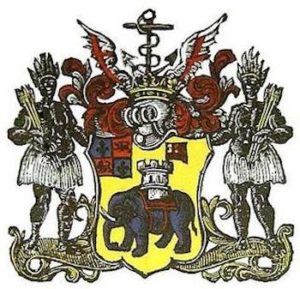
Royal African Company (shield)
*On this Indigenous Peoples Day, the 1662 founding of the Royal African Company (RAC) is briefly examined. This was an Irish/English commercial slave trading company set up by the royal Stuart family and the City of London to trade along the west coast of Africa.
It was led by the Duke of York, who was the brother of Charles II and later took the throne as James II. Soon after his ascension to the throne in 1660, King Charles II granted a charter to the Company of Royal Adventurers Trading to Africa, renamed the Royal African Company (RAC). This company was given a monopoly over British trade with a region in western Africa. Its original purpose was to exploit the gold fields up the Gambia River. Its agents soon engaged in the slave trade, as well as with other commodities. It traded mainly with the Gold Coast's peoples, now Ghana.
In 1752, RAC's assets were transferred to the new African Company of Merchants; by its charter issued in 1660, it was granted a monopoly over English trade along the West coast of Africa, with the principal objective being the search for gold. In 1663 a new charter was obtained, which included the trade of slaves. With the help of the army and navy, it established forts on the West African coast for staging and trading stations and seizing any English ships that violated the company's monopoly. In the "prize court," the King received half of the proceeds and the company half from seizing these ships.
The company fell into debt during the 1667 war with the Netherlands. It had lost most of its forts on the African coast except for Cape Corse. For several years after that, the RAC maintained some trade, including licensing single-trip private traders, but its biggest effort was the creation of the Gambia Adventurers in 1668. In January 1669, this new company was separately subscribed and granted a ten-year license for African trade north of the Bight of Benin.
In 1672, the original Company re-emerged with a new charter from the king as the new Royal African Company. Its new charter set up forts and factories, maintain troops and exercised martial law in West Africa in pursuit of trade in gold, silver, and African slaves. At the end of 1678, the license to the Gambia Adventurers expired, and its Gambian trade was merged into the company until 1821. In the 1680s, the Company transported about 5,000 slaves a year to markets primarily in the Caribbean across the Atlantic. Many were branded with the letters "DY" for its Governor, the Duke of York, who succeeded his brother on the throne in 1685, becoming King James II. Other slaves were branded with the company's initials, RAC, on their chests.
From 1694 to 1700, the company instigated the Komenda Wars in the port city of Komenda in the Eguafo Kingdom in modern-day Ghana. The company allied with a merchant prince named John Cabess and various neighboring African kingdoms to depose the king of Eguafo and establish a permanent fort and factory in Komenda. In 1689, the Company acknowledged that it had lost its monopoly with the end of royal power in the Glorious Revolution, and it ceased issuing letters of marque.
To maintain the company and its infrastructure and end its monopoly, parliament passed the Trade with Africa Act 1697 (9 Will. 3 c. 26). Among other provisions, this act opened the African trade to all English merchants who paid a ten percent levy to the Company on all goods exported from Africa. This development was advantageous for merchants in Bristol even if, like the Bristolian Edward Colston, they had already been involved in the trade. The number of slaves transported on English ships increased dramatically. The Company continued purchasing and transporting slaves until 1731 when it abandoned slaves in favor of ivory and gold dust. From 1668 to 1722, the Royal African Company provided gold to the English Mint. Coins made with such gold were designed with an elephant below the bust of the king and/or queen. This gold also gave the coinage its name, the guinea.
Records show that between 1662 and 1731, the Company transported approximately 212,000 slaves, of whom 44,000 died en route of the Middle Passage. By that time, they also transported slaves to English colonies in North America. Ship’s crew mortality rates were often similar and sometimes greater than the mortality rates amongst the slaves. Its profits made a major contribution to the increase in the financial power of those who controlled the City of London. The RAC lasted until 1752.
